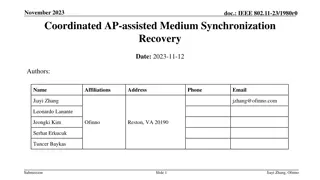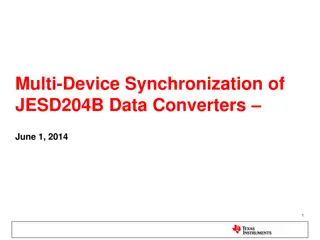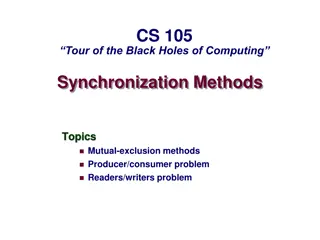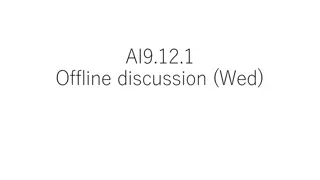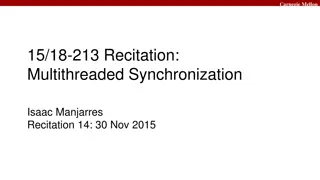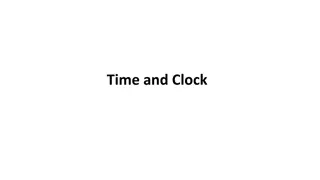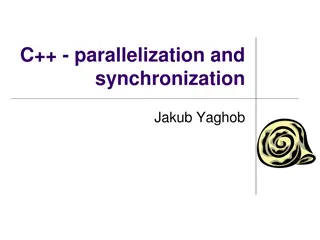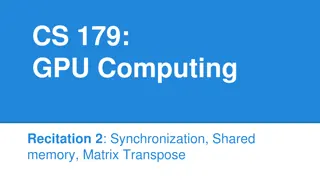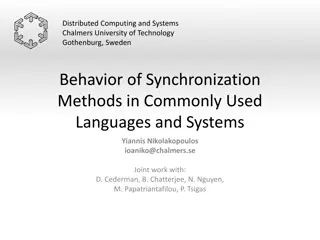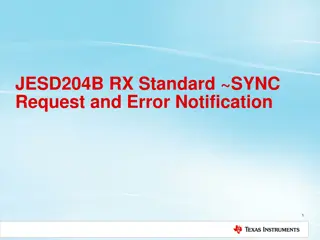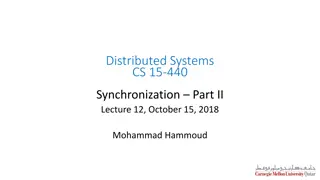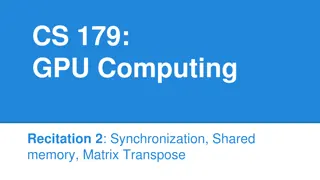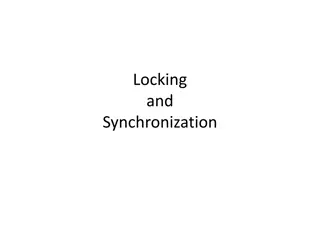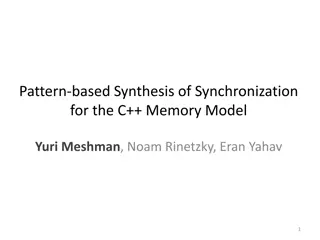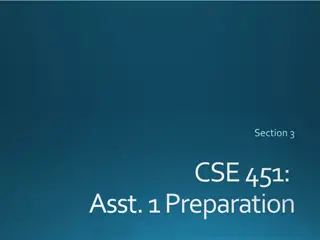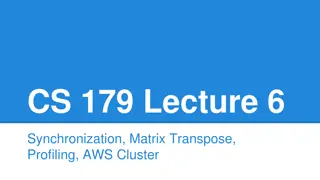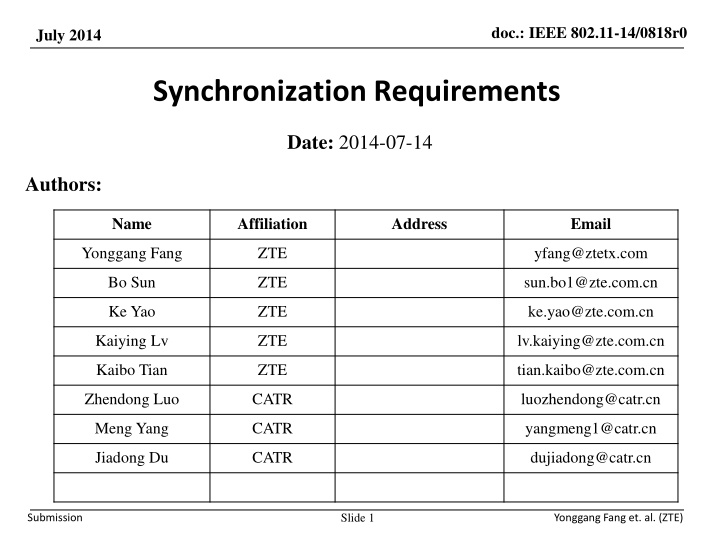
IEEE 802.11-14 Synchronization Requirements Analysis
"Explore the synchronization requirements for IEEE 802.11-14, focusing on frequency and timing aspects for improved spectrum efficiency in wireless transmissions. Analyze the impact of synchronization errors on system performance and propose necessary specifications."
Download Presentation

Please find below an Image/Link to download the presentation.
The content on the website is provided AS IS for your information and personal use only. It may not be sold, licensed, or shared on other websites without obtaining consent from the author. If you encounter any issues during the download, it is possible that the publisher has removed the file from their server.
You are allowed to download the files provided on this website for personal or commercial use, subject to the condition that they are used lawfully. All files are the property of their respective owners.
The content on the website is provided AS IS for your information and personal use only. It may not be sold, licensed, or shared on other websites without obtaining consent from the author.
E N D
Presentation Transcript
doc.: IEEE 802.11-14/0818r0 July 2014 Synchronization Requirements Date: 2014-07-14 Authors: Name Affiliation Address Email Yonggang Fang ZTE yfang@ztetx.com Bo Sun ZTE sun.bo1@zte.com.cn Ke Yao ZTE ke.yao@zte.com.cn Kaiying Lv ZTE lv.kaiying@zte.com.cn Kaibo Tian ZTE tian.kaibo@zte.com.cn Zhendong Luo CATR luozhendong@catr.cn Meng Yang CATR yangmeng1@catr.cn Jiadong Du CATR dujiadong@catr.cn Slide 1 Submission Yonggang Fang et. al. (ZTE)
doc.: IEEE 802.11-14/0818r0 July 2014 Abstract The synchronization between AP and multiple STAs is needed for some features, like UL OFDMA, UL MU MIMO and code based contention to improve the spectrum efficiency. This contribution analyzes the frequency and timing synchronization via comparing the results from difference source and the similar requirements from LTE, and suggests some synchronization requirements in IEEE 802.11 AX specification. Submission Slide 2 Yonggang Fang et. al. (ZTE)
doc.: IEEE 802.11-14/0818r0 July 2014 Overview OFDM system is sensitive to synchronization error. Therefore some features require synchronization error between multiple STAs and AP within a given threshold. UL MU OFDMA [8] UL MU MIMO [9] Enhancement of CSMA/CA [10] Synchronization requirements contain two aspects: frequency synchronization and timing synchronization. Synchronization error would impact system performance. Each wireless specification needs to give its synchronization requirements so as to achieve the expected system performance in the wireless transmission. Slide 3 Submission Yonggang Fang et. al. (ZTE)
doc.: IEEE 802.11-14/0818r0 July 2014 Impact by Frequency Synchronization Error SNR Degradation [1], [2] and [4] give the overall impact on SNR for relative small frequency errors. The degradation could be formulated by SNRloss= 10 ( Tf )2Es /(3ln10) N0 (dB) From the analysis, 1% frequency synchronization error will cause 0.5dB SNR degradation at 64 QAM, or 10-4 BER. Submission Slide 4 Yonggang Fang et. al. (ZTE)
doc.: IEEE 802.11-14/0818r0 July 2014 Impact by Frequency Synchronization Error Constellation Rotation Frequency synchronization errors will cause constellation rotation, especially in long frame transmission [3] shows the constellation rotation in 10 received symbols at frequency 1% synchronization errors. Submission Slide 5 Yonggang Fang et. al. (ZTE)
doc.: IEEE 802.11-14/0818r0 July 2014 Frequency Synchronization Analysis IEEE802.11 High Throughput PHY Specification [4] But it does not define the requirement for the frequency synchronization error between carrier frequency of STA and AP. Parameters Requirements Notes Transmit center frequency and symbol clock frequency tolerance 20 ppm for 5GHz band 25 ppm for 2.4GHz band = 100 KHz = 31% error of subcarrier spacing = 60 KHz = 19% error of subcarrier spacing Subcarrier spacing = 312.5 KHz Submission Slide 6 Yonggang Fang et. al. (ZTE)
doc.: IEEE 802.11-14/0818r0 July 2014 Frequency Synchronization Analysis 3GPP Frequency Synchronization [7] Parameters Requirements Notes BS Frequency Tolerance 0.05 ppm (wide area BS) 0.10 ppm (local area BS) 0.25 ppm (home BS) = 100 Hz = 0.6% = 200 Hz = 1.3% = 500 Hz = 3% error of subcarrier spacing (15KHz) UE Frequency Tolerance UE carrier frequency shall be accurate to within 0.1 ppm observed over a period of one time slot (0.5 ms) compared to the carrier frequency received from the E-UTRA Node B UE Intra-band contiguous carrier aggregation UE modulated carrier frequencies per band shall be accurate to within 0.1 ppm observed over a period of one timeslot compared to the carrier frequency of primary component carrier received from the E-UTRA in the corresponding band. UE UL-MIMO UE modulated carrier frequency at each transmit antenna connector shall be accurate to within 0.1 PPM observed over a period of one time slot (0.5 ms) compared to the carrier frequency received from the E-UTRA Node B. Submission Slide 7 Yonggang Fang et. al. (ZTE)
doc.: IEEE 802.11-14/0818r0 July 2014 Frequency Synchronization Analysis Frequency Synchronization Tolerance [6] presented the simulation result on the impact of PER-SNR by UL frequency difference among STAs. 0 10 AP has 8 antennas, 6 STAs with single stream uplink MMSE with ideal training but with pilot phase tracking per client 1000B packets, 64-QAM, rate 5/6, channel D-NLOS Frequency errors a) 0, c) 4 kHz, -1 10 PER a d b c -2 10 b) 2 kHz, d) 8 kHz -3 10 28 28.5 29 29.5 30 30.5 31 SNR [dB] Submission Slide 8 Yonggang Fang et. al. (ZTE)
doc.: IEEE 802.11-14/0818r0 July 2014 Proposal - 1 Requirement of Frequency Synchronization For 5GHz band, the carrier frequency synchronization error between the carrier frequency of STA and the carrier frequency received from the AP shall be within N1 ppm (TBD) Note: this will be equivalent to N% (TBD) error at 312.5 subcarrier spacing. For the 2.4GHz band, the carrier frequency synchronization error between the carrier frequency of STA and the carrier frequency received from the AP shall be within N2 ppm (TBD) Note: this will be equivalent to N% (TBD) error at 312.5 subcarrier spacing. Submission Slide 9 Yonggang Fang et. al. (ZTE)
doc.: IEEE 802.11-14/0818r0 July 2014 Timing Synchronization Analysis IEEE 802.11 Timing Requirements Assume to use parameters defined in current IEEE 802.11 spec In TGn and TGac, the GI (or CP) of symbol is defined as 0.8us. Channel Models A-E used for indoor [5]. Timing synchronization error tolerance may be related to GI (or CP). Channel Model C 2 taps 30 A B D E # of clusters RMS Delay Spread (ns) Max delay (ns) Max Cell Size (CP = 800ns) 1 tap 0 2 taps 15 3 taps 50 4 taps 100 0 80 200 90m 390 61m 730 10m 120m 108m Submission Slide 10 Yonggang Fang et. al. (ZTE)
doc.: IEEE 802.11-14/0818r0 July 2014 Timing Synchronization Analysis IEEE 802.11 Timing Requirements IEEE 802.11 does not define the timing synchronization requirement between STA and AP. The timing synchronization error between the AP and STAs will reduce the delay tolerance in GI/CP for multi-path protection. The more error in the timing synchronization, the less multi-path tolerance. The longer CP, the loose timing synchronization requirement, but it would reduce the efficiency. Timing Synchronization Error Max delay CP Submission Slide 11 Yonggang Fang et. al. (ZTE)
doc.: IEEE 802.11-14/0818r0 July 2014 Timing Synchronization Analysis 3GPP LTE Timing Requirements [7] For UL-MIMO For UE(s) with multiple transmit antenna connectors, the Time Alignment Error (TAE) shall not exceed 130 ns. Submission Slide 12 Yonggang Fang et. al. (ZTE)
doc.: IEEE 802.11-14/0818r0 July 2014 Timing Synchronization Analysis UL Timing Difference Impact on PER-SNR [6] also simulated the cases for different timing error to impact the PER-SNR curves 10 0 AP has 8 antennas, 6 STAs with single stream uplink MMSE with ideal training but with pilot phase tracking per client 1000B packets, 64-QAM, rate 5/6, channel D-NLOS Timing differences a) 0, c) 400ns, -1 10 PER d -2 10 b) 200ns, d) 600ns a c b -3 10 24 25 26 27 28 29 30 31 32 33 34 SNR [dB] Submission Slide 13 Yonggang Fang et. al. (ZTE)
doc.: IEEE 802.11-14/0818r0 July 2014 Proposal-2 Timing Synchronization Requirement We suggest to define the time synchronization requirement as The symbol timing synchronization between the transmit symbol boundary of STA and the received symbol boundary from the AP shall be aligned within the M ns (TBD) for the current CP length defined in IEEE 802.11. Submission Slide 14 Yonggang Fang et. al. (ZTE)
doc.: IEEE 802.11-14/0818r0 July 2014 Summary Benefits of Control Frequency/Timing Sync Errors Improve the system performance (SINR, PER) Improve the multipath tolerance in OFDM system We suggest to define requirements for synchronization The carrier frequency synchronization error between the carrier frequency of STA and the carrier frequency received from the AP shall be within N% (TBD) of sub- carrier space. The transmit time measured at the STA antenna port shall be aligned with the symbol boundary of received frame from AP within M ns (TBD). Submission Slide 15 Yonggang Fang et. al. (ZTE)
doc.: IEEE 802.11-14/0818r0 July 2014 Straw Poll 1 Do you support to add in FRD the requirement about the residual error of frequency synchronization between the carrier frequency of STA and the carrier frequency received from the AP? Yes: No: Abstain: Submission Slide 16 Yonggang Fang et. al. (ZTE)
doc.: IEEE 802.11-14/0818r0 July 2014 Straw Poll 2 Do you support to add in FRD the requirement about the transmit timing alignment with the symbol boundary of received frame from AP? Yes No: Abstain: Submission Slide 17 Yonggang Fang et. al. (ZTE)
doc.: IEEE 802.11-14/0818r0 July 2014 References 1. T Pollet, M. etc. BER Sensitivity of OFDM Systems to Carrier Frequency Offset and Wiener Phase Noise , IEEE Transactions on Communiucations, Vol 43, Issue 2, Part 3, February, March, April 1995, pp. 191-193 Ting-Jung Liang, etc. Synchronization in OFDM-based WLAN with Transmit and Receive Diversities , Juha Heiskala, etc. OFDM Wireless LANs: A Theoretical and Practival Guide. IEEE 802.11 Specification IEEE 802.11 11-03-0940-04-000n-tgn-channel-models IEEE 802.11 11-09-1036-00-00ac-uplink-mu-mimo-sensitivity-to-power- differences-and-synchronization-errors 3GPP TS 36.101 IEEE 802.11 11-13-1388-00-0hew-ul-mu-transmission IEEE 802.11 11-09-0852-00-00ac-ul-mu-mimo-for-11ac 10. IEEE 802.11 11-14-0616-00-00ax-CSMA-enhancement-suggestion 2. 3. 4. 5. 6. 7. 8. 9. Slide 18 Submission Yonggang Fang et. al. (ZTE)


